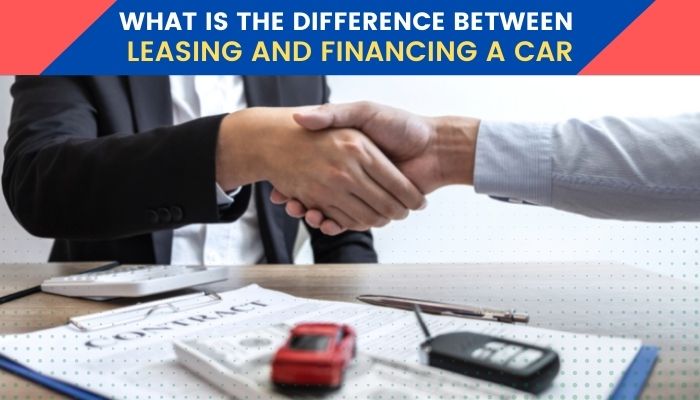Refinancing a Leased Car with Bad Credit
Most people prefer leasing a car to purchasing one due to the lower monthly payments on a lease. That’s because lessees do not pay the vehicle’s total price but only a fraction representing the expected depreciation.
Even though leasing results in lower monthly payments, it can be expensive if you fail to negotiate the deal properly. For example, the average monthly car lease payment for 2019 was $450 plus upfront costs, end-of-lease fees, and mileage fees.
Besides, those who lease a car with bad credit end up with exorbitantly high monthly payments. Even though refinancing a used car with bad credit can be difficult, it could be the only option you have. It can help you save money and use it to meet your other needs.
But just how does refinancing a leased car work? It is different from refinancing a loan. To refinance a lease, all you need is to take out a loan for the car’s remaining value. This article explains everything you need to know about refinancing a car lease.
Does Refinancing a Leased Car Lead to Lower Payments?
When you find yourself in financial difficulty, don’t hesitate to refinance it. That will lower the monthly payments and bring you back on the path to sound finances. It is the perfect way of disentangling yourself from the original lease contract that resulted in high monthly payments. By refinancing a lease, you can avoid the following fees, which come at the end of the period.
- Lease cancellation fees
- Maintenance fees
- Mileage fees
- Wear and tear fees
Refinancing is the best way of preserving the equity of the car. For example, you can sell the vehicle at a higher price if the vehicle’s value is less than the lease buyout.
Alternatives to Refinancing a Leased Car
While refinancing a car lease is a good option, it isn’t the only way to get out of excessive monthly payments. You can opt for any of the following:
- Transferring the Lease: If you can no longer afford to pay for the lease due to bad credit, the best option is to move it to someone else. However, you will have to consult the leasing company if that option is available to you. Before the company approves a lease transfer, it may require a credit check on the new lessee. Most companies charge a transfer fee before allowing someone else to take responsibility for it.
- Purchasing the Car: The chances are that you have fallen in love with the car after driving it for some time. In that case, you may want to refinance the lease or wait until it ends to purchase the vehicle outright. Once the car becomes yours, you may choose to sell it to a private party or another dealership.
- Utilizing a Lease Pull-Ahead: As you approach the end of the lease, the leasing company may offer you a lease pull-ahead program. With that, you can lease a new vehicle and skip the last couple of payments. Also, you will avoid paying the termination fees. However, if you’re in breach of the mileage limit, the leasing company will still require you to pay the penalty.
- Returning and Leasing Again: You can return the car and ask to lease a new one when the lease ends. With that, the leasing company will exempt you from paying a lease termination fee.
When to Refinance a Car Lease?
Your car lease has the option for you to buy out the moment you drive away with the car if you have the cash required. Therefore, you can refinance your lease whenever you want. However, some leasing companies sneak in provisions preventing a lease buyback. That’s why you should check the lease for any such provision.
Refinancing a lease involves getting credit from another institution. That’s means that you should have the ability to secure the loan you need to go through with refinancing. Once you confirm the loan, you will be able to lower your monthly payments, purchase the car outright, or withdraw from the contract early.
How to Refinance a Car Lease?
Once you have decided to refinance your car lease, you can approach the leasing company for the available options. The is a step-by-step process of refinancing a car lease:
Step 1: Think About the Timing of the Lease
The timing of a lease refinancing can be more important than the process. That’s because the timing has the most significant influence on the price you have to pay. If you opt to buy the car before the lease expires, you are liable for extra finance charges. So, carefully study the terms of your lease agreement to know what to expect from the leasing company. If you want the cheapest refinancing deal, wait for the period of the lease to end.
Step 2: Get Information on Your Payout
The first step is to approach the leasing company for the payout information, which specifies the amount you can spend to purchase the vehicle. Once you get that figure, you should subtract the sales tax. It would help if you also considered when the information is likely to change. Usually, payout information may change after three to thirty days. For that reason, you should use it as soon as possible.
Step 3: Pursue Lease Refinance Offers
Refinancing a leased car with bad credit is only possible if you get offers from concerned companies. You don’t need to visit the leasing companies physically. A simple Google search can reveal numerous websites of companies offering car lease refinance. You can then compare the deals available on the websites and pick one with the lowest rates. Be careful not to fall victim to fraudsters by checking out every lender to ascertain their legitimacy.
Step 4: Review Refinance Offers
After obtaining several refinancing offers, take time to review them to choose the most attractive deal. In that case, the best deal might not necessarily be the one with the lowest price. That’s because the sales have other components like vehicle warranty, mileage, and maintenance fees. Before signing the agreement, check out the finance company.
Step 5: Complete the Paperwork
Every car lease refinances deal will culminate in the signing of a contract. Usually, the company sends several copies of the agreement, so sign all of them. Reading the contracts before signing them is the only way to avoid falling prey to excessive hidden charges. So be sure to do that. Once the agreement gets approved, the lender will pay off the vehicle, commencing a new lease.
How Leased Car Refinancing Works?
When you refinance a lease, you become the owner of the car. It involves securing a loan to purchase the vehicle instead of making monthly lease payments. If you refinance a car lease too early, the new contract will include all the fees you would have made on the lease.
Under lease refinancing, you do not make lease payments but installments of the loan amount. In short, your lease terms will automatically expire the moment you sign a deal for refinancing. However, your credit score will determine just how much lease financing reduces your monthly payments.
Drawbacks of Car Lease Refinancing
- It involves the payment of other upfront fees
- You might still have to pay the lease termination fees
- Involves payment of state taxes, and transfer costs
- The lease contract may also result in higher monthly payments
- Since it is a used car, the loan interest could be higher
- The payoff could be higher than the value of the car
How to Negotiate the Payoff Amount?
Some leasing companies might deny you the option to negotiate the payoff amount. That’s why you should find out if negotiation is possible. If you return the car without refinancing, they will have to sell it at an auction. The company can avoid that by agreeing to negotiate the payoff amount. It helps if you know the value of the vehicle to get the best possible leverage.
You can use an online value calculator to establish just how much your car is worth. Now compare the buyout price with the amount you got as the fair price value. If the fair value is above the payoff, great. You can refinance the car and sell it at a profit. However, the leasing company might decline to renegotiate the payoff amount.
If the payoff is higher than the fair value, there is room for negotiation. If you still have two to three months, give the leasing company to come to you with a reasonable offer. If the company doesn’t call you, then you have to approach it with a negotiation offer.
Inform the company that, even though you have cash, you would like to negotiate the payoff. The older the car is, the more likely you are to have the company agree to negotiate. That’s because the company wouldn’t be willing to hold onto an old vehicle instead of taking the cash.
Refinancing a Leased Car with Bad Credit
Even though refinancing a leased car with bad credit is possible, it takes a considerable amount of work. Many leasing companies consider a credit score under 600 to be subprime or bad. Ideally, it would help if you had a credit rating between 600 to 850 to lease a car and secure any form of finance.
After establishing that your credit score is below 600, find a lender who has no trouble dealing with individuals with bad credit. Check that the lender:
- Has low or no credit score requirements
- Accepts lease buyout loans
- Can give you a substantial loan to cover the payoff amount
After finding several bad-credit lenders, ask them for quotes. You can then compare the selections for the best possible deal. With quotes from three or more companies, you are likely to get the best rates.
With bad credit, you should be ready to pay higher interest on the loan. But that won’t be a great deal, especially if you want to buy the car. Even though the monthly loan repayment can be less than the lease, it will likely remain the same. Lenders won’t reduce the payments significantly since they consider you a risky borrower, owing to your low credit.
Conclusion
Refinancing a leased car with bad credit is one of the best ways to stop making expensive lease payments. Even though it is hard to get approval, several lenders specialize in bad credit, giving you the opportunity you need to reduce your financial burden. After finding the right lender, negotiate for the cheapest possible rates. Once you get the loan, you can pay for the car and make it yours. If you have leverage on the payoff, don’t hesitate to make some money by selling it.
Frequently Asked Questions (FAQ)
Can I refinance a car lease with bad credit?
Yes. You can refinance a car with bad credit. However, you may have to look for lenders who specialize in individuals with bad credit. It then becomes necessary to compare the deals from different lenders before choosing the most affordable one.
Can I refinance a car lease before its term ends?
Yes. You can refinance a car lease before its term ends. That means that instead of making regular lease payments, you choose to get financing from a lender to purchase the car on credit. That’s possible even a day after signing the lease agreement.
How can I lower my lease payments?
You can lower your lease payments by negotiating a lower interest rate, picking a longer lease term, making a substantial down payment, or using a co-signor. Refinancing a car lease is also a great way to reduce monthly payments.
Does refinancing a leased car hurt your credit?
Yes. Like any other new debt, refinancing a leased car can cause a significant reduction in your credit score. However, the effect on your credit rating is minimal since refinancing replaces another loan of a similar amount.
How many times does your credit get pulled when refinancing a leased car?
When refinancing a leased car, a lender pulls credit at the beginning and just before closing the deal. That’s why you have to be careful not to damage your credit before closing the deal.




